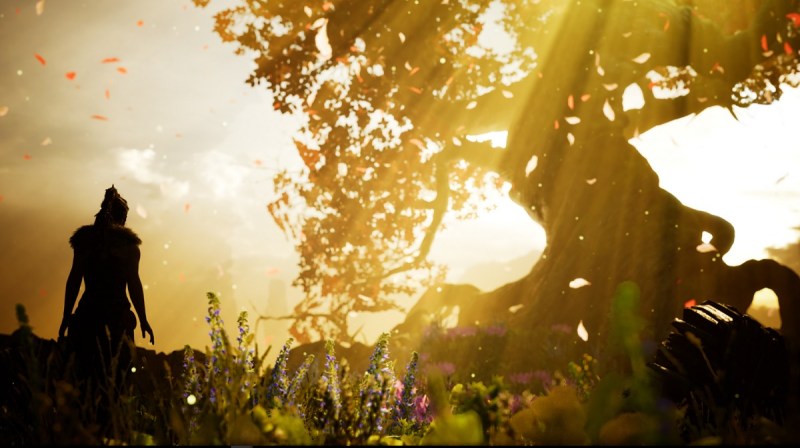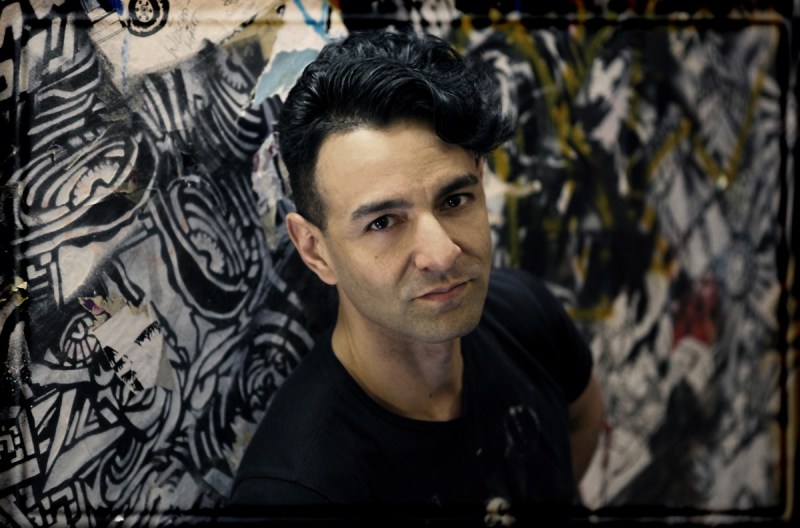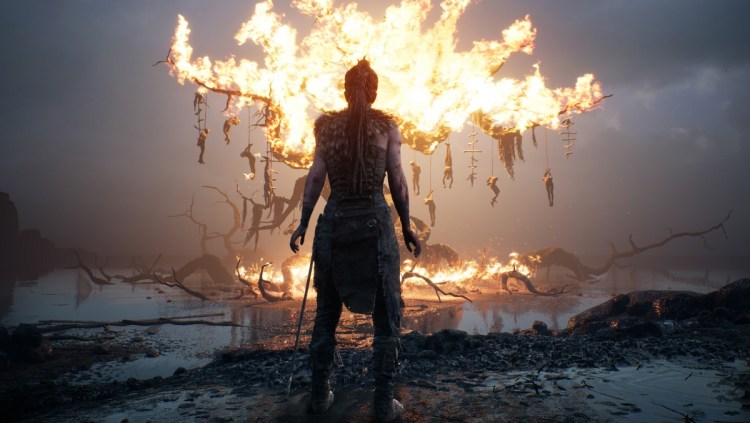Hellblade: Senua’s Sacrifice is one of the best games of the year, with its terrifying account of a warrior’s journey into the depths of the Norse underworld — and into madness itself.
The game from British game studio Ninja Theory came out on August 8, and if you haven’t played it yet, you ought to. I reviewed Hellblade in August and gave it a score of 95 out of 100, the highest I’ve given this year. But fair warning, it’s hard to experience because the depiction of psychosis of the Celtic warrior Senua is haunting, as she struggles with inner demons locked in a battle over her mind.
Senua’s story was created by a team headed by Tameem Antoniades, chief creative director at Ninja Theory. The labor of love took four years for Ninja Theory to make, and the studio infused the hack-and-slash fantasy game with a realistic depiction of a character suffering from psychosis — or seeing things in the world that aren’t real. Senua can’t tell whether the demons she sees with her eyes or the voices in her head are real or not.

Above: Dream or nightmare in Hellblade.
To refine this story, Biomedical research charity Wellcome Trust gave Ninja Theory a $395,000 grant to do research on mental illness, and that helped Ninja Theory make such an ambitious and research-based game on its own as an independent studio. Ninja Theory’s Melina Juergens created a video documentary of the research and the game’s development, and the company even created a website to find out more about mental illness.
Ninja Theory combined that research about Senua and psychosis with the hellish environment and extremely detailed facial animations that looked completely real. As Senua descends into the underworld and does battle with monsters, you can’t really tell what’s real and what’s not. I talked with Antoniades for an in-depth postmortem on what the tale was about, how Ninja Theory made the game, what was real and what was fantasy, and what was the meaning of its cryptic ending.
For me, it was a rare pleasure to experience a work of art and then interview its creator about how it came to be. It is also gratifying to see that Hellblade is going to pay off commercially in profits just a few months after its publication.
Here’s an edited transcript of our interview.
Editor’s note: This story has narrative spoilers.

Above: Tameem Antoniades, a lead developer on Hellblade and chief creative director at Ninja Theory.
GamesBeat: Can you summarize how you made the game with the help of mental health experts, the folks from Cambridge University and Wellcome Trust?
Antoniades: Once we had decided that the game was about — it was more about fantasy and psychosis and how they relate to myth. Right at the start of the project, we knew it was not an easy subject to tackle. The potential for backlash, if we did it wrong, would be immense. We wanted to do our research.
We looked up who was local that could help us, and professor Paul Fletcher came up. We just Googled him. It turns out he’s a psychiatrist and a leading expert in psychosis, so we got in touch with him. He came to visit the studio. We also got in touch with Wellcome, the second biggest charity in the world, actually.
Both of those meetings went really well. Paul just talked to us. He gave us some pointers, some advice on what we needed to learn and understand. After meeting him, we wanted him to be on board as part of the team as a collaborator. Wellcome, at the same time, gave us a grant. It’s called a co-development grant, and I think it was either half a million dollars or half a million pounds. They did that, so we could consult with Paul and other groups. They encouraged us to meet with as many diverse groups as possible.
Through them, we were in touch with Recovery College East, the main collaborators. Tracey [Tingey], who runs this group, invited several people to the studio, all people who have lived experience of psychosis and mental illness. They were all willing to talk and share about their experiences. We kept coming back to them every two or three months or so, right from the time we announced the project. In the design stages in the project, we met with them, and we continued to meet with them. We’d show them what we were doing and talk to them about their experiences. Then, we folded that all into the game design and kept doing that until we finished the game.
The development of the game was very fluid. The story was developing as we were learning more. The gameplay and the levels and art were developed alongside their feedback. We also spoke to a bunch of other people. There’s a voice-hearing group called the Voice Collective, which is an interesting group. It represents voice-hearers, people who acknowledge that they hear voices but who do not subscribe to the idea that that makes them mentally ill. We met with a group of people who would describe themselves as severely mentally ill. It was quite a broad range of people and experts in the end.
This was largely thanks to Wellcome and Paul Fletcher. Wellcome gave us the funding with which to take our research seriously, and Paul gave us the guidance. He was like our mentor on the project with regards to mental health.
GamesBeat: Where did you pick up the initial empathy for a character like Senua? Psychosis tends to be attached to characters in fiction who are villains, not heroes.
Antoniades: That’s how it’s represented in most media, yeah. I think it’s not quite right. There’s a mix-up between the term “psychosis” and psychopathy. Psychosis is a break with reality. Psychopathy is a lack of empathy. Those two words are used interchangeably, even in documentaries about these subjects, and it effectively means that when you hear someone has psychosis, you think they’re psychopathic, which is a totally different thing. It basically means that if you hear voices, see visions, or have delusional beliefs, you’re automatically assumed to be dangerous. That’s where the trouble starts. It’s something I had to learn about as well, the distinction.
It’s a great disservice that the media has propagated. It’s probably caused a lot of suffering in people who experience these things. It makes them feel ashamed to admit that they have these conditions. For me, it was a learning process as well. I’m not ashamed to say now that I came into this from a position of real ignorance.
So yeah, to do a game where we try to get to the science and the truth behind it was illuminating. It didn’t take us, perhaps, in the direction that people would assume. It led us to a much more personal, introspective journey than we initially thought we would go on.

Above: Senua is an ordinary character, except for the blue tattoo.
GamesBeat: At some point, did you know what you wanted to say with the game?
Antoniades: It developed. At first, I wanted to see if we could recreate the experience, to put yourself in someone’s shoes who experiences psychosis. On the surface, it’s a very visceral experience, being able to hear voices, to see visions. It’s a very literal experience. People talk about seeing demons, and they mean it. Strange belief systems, seeing signs and patterns everywhere, these are [things] that I thought — a video game is actually a good medium for this stuff.
As we did more and more talking, more interviews, the human cost came through. Then, it became more of a character study, dissecting her life. Senua is an amalgamation of a lot of people’s experiences. She could always see the world differently. She could always hear voices. But it took trauma, stigma, misunderstandings by her father and other people, to turn that into a negative experience, which then haunted her.
That mirrors what a lot of people experience. It’s not so much the symptoms that are the mental illness part, if you like. It’s the suffering at the hands of others that makes those symptoms intolerable or turns them negative in a way.
GamesBeat: I was fascinated by how you incorporated her ability to see the world differently into the puzzles. That was an interesting integration of the theme into gameplay.
Antoniades: It’s based on research that Paul Fletcher has done, where in tests, when you’re looking at random noise and you ask people whether they can see a hidden image or something in it, people that are predisposed to psychosis, if you like, pick out those patterns much quicker than the general population.
I actually think that a lot of those abilities to see patterns and stuff — it doesn’t indicate a mental condition at all. Some people are better at seeing patterns in the world than others. That doesn’t necessarily mean you’re psychotic. It’s a natural part of who we are and how we experience the world. But in extreme cases of psychosis, it’s very evident in people.

Above: Senua’s journey in Hellblade.
GamesBeat: Did you find that most people understood what you were trying to get, as far as feedback to the game?
Antoniades: I think I’ve been more than — I’ve been very surprised, to be honest, at how understanding people have been. I thought the game would be very controversial, that there would be a camp that’s dead against what we were doing, and there would be quite a raging debate over whether it’s morally right to represent these things in a video game, especially a video game about a warrior with a sword, given the associations with violence. In fact, the discussion around the game has been very mature and understanding, amongst gamers and amongst healthcare professionals.
As you know, the gaming audience can be quite harsh and brutal when you get into discussing things anonymously online. To see quite a mature conversation surrounding this and to see people who have been touched by the game — it’s a better outcome than I imagined was possible. I did have some crises of confidence making the game, just thinking, “How can this game possibly have a good outcome?” But thankfully, I’m satisfied. Some people have a counter-view on it, but that’s remarkably minor compared to the overwhelming positive reactions we’ve had.
GamesBeat: I saw one story that ran in Polygon from a person that had mental illness.
Antoniades: That’s OK. In my view, the game is hugely metaphorical. It’s not usual to have a film or a game that tells a story that’s so metaphorical. It’s open to interpretation. Every voice in reaction to that has validity. Her view is just as valid as every other player’s view. I did think there would be a lot more of that.
GamesBeat: Did you hear back whether people felt the game was therapeutic or something that mentally ill people maybe should not play?
Antoniades: The groups we spoke to throughout development, they were extremely open. They suggested we put in a warning at the start of the game because if you have experienced those things, it can be frightening. They asked us to put that warning in, but they totally encouraged us to go down the path we were going and to show it as they see it, as it is — show it in its true horror, if you like.

